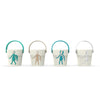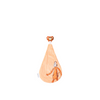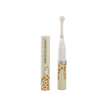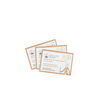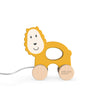Mindfulness Exercises for New Parents
Think of exercising with mindfulness as an act of purpose. It’s a way to train your mind and body; to realign with yourself in the current moment. When you practice mindful exercises, you encourage peaceful thinking and create space to cope with stressful moments. The good news is, mindfulness requires zero equipment - just you. And it’s simple to begin practicing.
What’s the Purpose of Mindfulness Exercises?
- Completing a mindfulness exercise will help you focus on the present
- Exercising with mindfulness will help you feel relaxed
- Mindfulness exercises provide you with decompression time
- To reset and recharge
- Mindfulness exercises help you to face the day and guide you through difficult times
Mindfulness Exercises For New Parents
We’ve supplied variations of mindfulness exercises below for you to try. You can repeat any of them as you feel fit. These exercises can be completed anywhere at any time.
The Hand Stroke
Use this exercise to activate focus used when exercising with mindfulness.
Starting with your left hand, lift it out in front of you, palm facing. Take your right hand and using your index finger, run your finger up and down your left hand (palm to tip of each finger.) Then, run your finger over the outer edge of your thumb and fingers and across the gaps. Repeat on your other side.
Stretch for 10 seconds
Nice and simple. Stretching your body every hour is an important part of exercising with mindfulness. Your body goes through a lot in one day so it’s important to stretch and wriggle around in it. For a whole 10 seconds, stretch out your body. Breathe in new, fresh air and visualise it pumping around your body. Exhale the used air and visualise it disappearing, making room for new breath.
Eating with Mindfulness
It might sound silly, but the benefits of trying an eating exercise with mindfulness outweighs the initial doubt. Try it for yourself! You will most likely feel relaxed and put at ease. (If not, at least you’ve had a small treat!)
A raisin is a good choice for this exercise but a grape or anything similar will work.
The exercise goes as follows:
- With your chosen snack, lift it in your hand and feel it.
- Bring it closer to your gaze, what does it look like?
- Can you smell it?
- Once you’ve mentally noticed the appearance and scent of the snack, pop it into your mouth.
- Roll it around in there for a moment and begin to sense how it feels and tastes.
- Begin to chew and acknowledge any sensation of flavour bursts or a change in texture.
- Swallow when you’re ready. Is there an aftertaste?
- Repeat and really try to tune into all of the sensations when eating a raisin.
This exercise is good for strengthening and conditioning your mindfulness. If you find it relaxing, you can use it anywhere and at any time to bring you into focus.
The STOP Method
The following exercise is designed to guide you with mindfulness so you can choose where you want to go from a situation. For example, if you are feeling anxious or overwhelmed.
Follow each step of the exercise as follows, repeat until you feel ready.
S - Stand up and breathe. Breathe in for 5 seconds and out for 5 seconds. Return to normal breath after a few cycles.
T- Tune in and scan your body. In your mind’s eye, start at the top of your head. Scan all the way down from your head, to your shoulders, neck, arms, back, side, legs, ankles and feet, right down to your toes. Did you notice any points during the scan where you feel tension or a sensation?
O - Observe your feelings and allow thoughts to come and go. Still breathing, take in your surroundings. What colours are around you? What do you think the ground feels like?
P - Possibility. What is your next step? What options are possible?
Recentre from feeling reactive
If you are struggling with feeling reactive or frustrated, try the following mindfulness exercise to help recentre. Repeat the exercise if you feel that you need to. It should help bring you recalibrate into a clear state of mind.
- Pause and take 1-3 deep breaths. Make them big, inhale and exhale with control.
- Say “step back” to yourself either outloud or in your head. You don’t have to take a physical step backwards.
- Then say, “clear head” pause, and say “calm body”.
- Take another breath, and say any of the following, “ease”, “melt” or “relax.”
- Allow yourself to settle and when you are ready you can return to the current moment feeling supported and clear of thought.
Regain Your Focus
When things are making you feel dizzy and out of control, try the following mindfulness exercise to help regain your focus.
This is an exercise on how to refocus through mindful breathing.
- Sitting comfortably, begin to lower your eyes.
- Notice your breathing. Do this by noticing where you feel it… in and out through your nostrils? Your chest and neck? Can you see your chest rising and falling? Good.
- Next, lift your hand and rest it on your chest. Let your hand guide your breathing as you see it rising and falling with the inhale and exhale.
- Notice how your body will breathe for you. You only need to observe it. To complete this exercise with mindfulness, you should focus on breathing only. Any internal chatter that arises, try to say “thinking” to your thoughts and gently, shepard them away.
- When you’re ready, you can begin to blink your eyes open and return, with focus.
Mindfulness Mantras
The purpose of a mantra is to release the mind and centre your awareness. It’s a tool used in meditation and the same benefits apply for mindfulness.
Try practicing the following mantras and assess how they make you feel afterwards. Mantras can be used in a daily practice routine e.g. when you’re getting ready in the morning or before you go to bed.
“May I be happy, may I be well, may I be filled with kindness and peace.” If you’d like to send this message to someone, you can replace the I’s with ‘you’ while you think of the person.
“I am fully present in the moment. I embrace the opportunity to experience the beautiful fullness of life.”
“I now release this energy of stress and replace it with self-compassion and trust that everything is taken care of in my life. I am now grounded in my heart space and reminded of the importance of self-care each and every day.”
Incorporating mindfulness into everyday life will help you feel relaxed, ready and in control of whatever the day has to offer.
Related blog: Post-Natal Exercises to Keep Fit and Healthy














